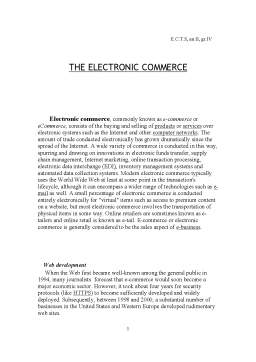Extras din proiect
Electronic commerce, commonly known as e-commerce or eCommerce, consists of the buying and selling of products or services over electronic systems such as the Internet and other computer networks. The amount of trade conducted electronically has grown dramatically since the spread of the Internet. A wide variety of commerce is conducted in this way, spurring and drawing on innovations in electronic funds transfer, supply chain management, Internet marketing, online transaction processing, electronic data interchange (EDI), inventory management systems and automated data collection systems. Modern electronic commerce typically uses the World Wide Web at least at some point in the transaction's lifecycle, although it can encompass a wider range of technologies such as e-mail as well. A small percentage of electronic commerce is conducted entirely electronically for "virtual" items such as access to premium content on a website, but most electronic commerce involves the transportation of physical items in some way. Online retailers are sometimes known as e-tailers and online retail is known as e-tail. E-commerce or electronic commerce is generally considered to be the sales aspect of e-business.
Web development
When the Web first became well-known among the general public in 1994, many journalists forecast that e-commerce would soon become a major economic sector. However, it took about four years for security protocols (like HTTPS) to become sufficiently developed and widely deployed. Subsequently, between 1998 and 2000, a substantial number of businesses in the United States and Western Europe developed rudimentary web sites.
In the dot com era, e-commerce came to include activities more precisely termed "Web commerce" -- the purchase of goods and services over the World Wide Web, usually with secure connections, with e-shopping carts and with electronic payment services such as credit card payment authorizations.
Although a large number of "pure e-commerce" companies disappeared during the dot-com collapse in 2000 and 2001, many retailers recognized that such companies had identified valuable niche markets and began to add e-commerce capabilities to their Web sites. For example, after the collapse of online grocer Webvan, two traditional supermarket chains, Albertsons and Safeway, both started e-commerce subsidiaries through which consumers could order groceries online.
The emergence of e-commerce also significantly lowered barriers to entry in the selling of many types of goods; many small home-based proprietors are able to use the internet to sell goods. Often, small sellers use online auction sites such as eBay, or sell via large corporate websites like Amazon.com, in order to take advantage of the exposure and setup convenience of such sites.
Currently there are many companies that have ecommerce revenues greater than $10 million. The 5 largest Internet retailers are Amazon, Staples, Office Depot, Dell, and Hewlett Packard. This indicates that the top categories of products sold on the Internet are books, music, office supplies, computers, and other consumer electronics.
Government Regulations
In the United States, some e-commerce activities are regulated by the Federal Trade Commission (FTC). These activities include the use of commercial e-mails, online advertising and consumer privacy. The Federal Trade Commission Act regulates all forms of advertising, including online advertising, and states that advertising must be truthful and non-deceptive.
Preview document
Conținut arhivă zip
- The Electronic Commerce.doc

















